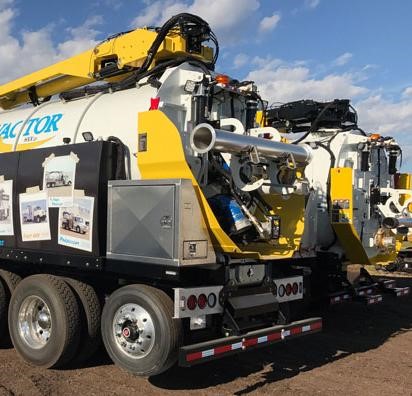Why is Hydrovac Weight an Issue?

Hydrovacs were developed in a number of different applications simultaneously – ranging from the oil and gas industry, where they were intended to work off-road and usually on leased roads, to the mining and utility markets. Weight was not a factor, but the ability to maximize load was. For utility applications in dense urban centres, the vehicles had a distinct legal categorization, which meant they were not necessarily subject to all of the same regulations as other vehicles with regard to weight restrictions.
With a growing awareness of damage protection, hydrovacs have become commonplace in utility and municipal industries. When hydrovacs began hauling on public roads, weight compliance and maneuverability became priority for both owners and operators. The growing use of hydrovacs and increased focus from enforcement agencies, has led to weight compliance.
Weight Considerations for your Hydrovac:
Density and Type of Material Being Loaded and Moved
Owners and operators should consider the application of the equipment when planning for weight compliance and payload. The density of the material being moved plays a factor in how long a piece of equipment can run before reaching legal payload capacity. For example, a yard of dirt is not just a yard (weight per yard) because material density varies so widely. A yard of dry material has a significantly lower weight than a yard of wet material. A shortcoming of many traditional hydrovacs was not just the weight of the vehicle, but how they distributed the weight. In recent years, substantial work has gone into redesigning hydrovacs to consistently distribute weight properly to achieve the goal of maximizing legal payload.
Hauling Route Regulations
There are many different heavy equipment compliance regulations to be aware of and follow. This can include provincial or federal laws, federal bridge laws, frost and thaw restrictions, vehicle classifications and many more. Not all regulations are consistent between municipalities and provinces. Be aware of the restrictions and plan accordingly.
Some areas will allow for overweight permits. These can range from job specific permits to an annual license per truck.
Gross Vehicle Weight Rating
When checking a hydrovac for weight compliance, officers will review the following: what weight is permissible based on axle locations and spacing, tire and axle ratings, the gross vehicle weight rating and gross axle weight rating. If the allowable axle weight is exceeded, even if the load is within the regulated gross weight, an overweight fine will be issued.
Water Tank Position and Level
The water tank in a hydrovac can be in several different locations based on the model: under the debris tank, in front of the debris tank, or around the debris tank. It is common to keep a few hundred gallons of water in the tank while hauling debris to clean the unit after the debris tank is emptied. Both the position and level of the water tank can have impacts on the weight of the truck and the weight distribution.
As shifting weight and unequal distribution can create unsafe driving conditions, many jurisdictions have regulations that require a minimum percentage of weight be kept on a vehicle’s front axle.
Hydrovac Weight Restrictions and Efficiency
While weight restriction compliance is a major challenge within the hydrovac community, it does not have to limit operational efficiency. By selecting the vehicle that best suits the main application or purpose of the equipment while meeting local regulation standards, payload can be maximized while avoiding costly overweight fines. Even after acquiring the right equipment, hydrovac weight compliance should be top of mind for any fleet manager or operator and something that is addressed on a job by job basis.
Is Your Hydrovac Weight Compliant?
